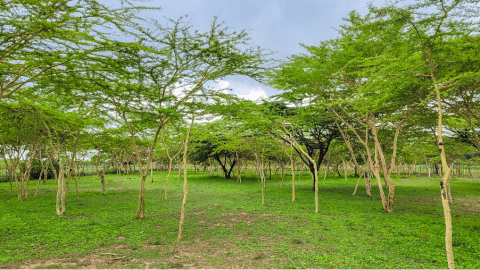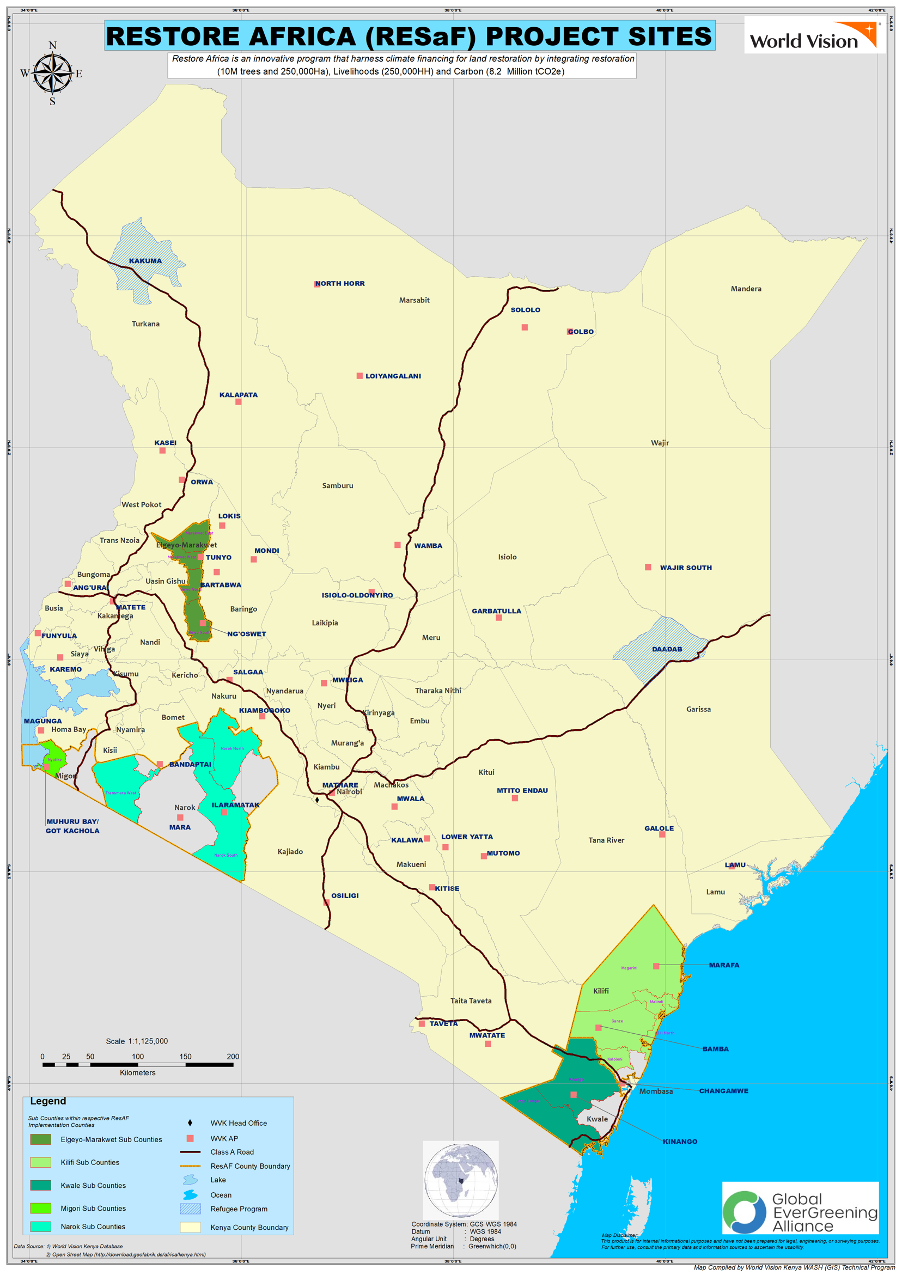
Restore Africa Program
The Global EverGreening Alliance’s Restore Africa Programme is a farmer-led integrated land restoration and livelihoods improvement programme that aims to capture carbon from the atmosphere to combat the effects of climate change.
The programme spans six (6) countries in East and Southern Africa that include: Kenya, Uganda, Zambia, Malawi, Tanzania and Ethiopia. The programme aims to restore over 1.8 million hectares of land and support more than 1.5 million farming families, while sequestering over 80 million tons of carbon.
Restore Africa: Restoring Landscapes and Livelihoods in East and Southern Africa with Climate Asset Management project is facilitated by the Global EverGreening Alliance through funding by the Climate Asset Management and implemented through a partnership of international and national NGOs.
In Kenya, the Restore Africa Programme implements restoration activities in Elgeyo Marakwet, Kilifi, Kwale, Migori, and Narok Counties and targets to sequester 11.1 million tons of carbon and restore 250,000 hectares of degraded lands. Through these achievements, the programme will improve the livelihoods of 250,000 small-scale farming / pastoral households.
Programme Goal: To build resilient and socio-ecological productive systems by 2052 through landscape restoration and livelihood building for 250,000 small-scale farmers and pastoralists (men, women, and youth) by working across 250,000 hectares of land in five (5) target counties in Kenya.
The programme seeks to achieve this goal through the following projected outcomes;
- Increased resilience and diversified livelihoods for smallholder households
- Improved sustainable income for communities from resilient climate-smart value chains
- Diversified and sustainable income streams through carbon market engagements
- Strengthened institutional, knowledge sharing, and regulatory systems/framework (policies) for climate-responsive planning/development and carbon trading.
Duration: 30 years
Intense Implementation Phase: Five (5) years: 1st July 2022 to 30th June 2027
Implementing Partners in Kenya:
- World Vision Kenya (WVK - PMU): Lead Implementing Organization: LIO
Responsible for coordinating the Consortium Partners, overall, in-country programme implementation, and overseeing donor compliance.
- World Vision Kenya (WVK - Kilifi)
Responsible for the implementation of programme activities in Kilifi and Kwale Counties.
Responsible for providing technical support to the Consortium Partners in relation to Agroforestry systems.
Responsible for providing technical support to the Consortium Partners in relation to Advocacy and Media & Communications at the grassroots level.
Responsible for the implementation of programme activities in Elgeyo Marakwet County.
Responsible for providing technical support to the Consortium Partners in relation to Climate Smart Resilience Value Chain.
Responsible for the implementation of programme activities in Narok and Migori Counties.
To achieve land restoration, improve livelihoods, income, and climate resilience for households/communities, and reduce carbon footprints, the programme will restore productive assets and create market incentives for sustainable productivity. Restore Africa will use proven nature-based (positive) solutions to deliver the objectives, including: -
- Ecosystem-based Adaptation (EbA) – A wide range of ecosystem and biodiversity management activities and services for climate change adaptation that will be implemented to increase the resilience and reduce the vulnerability of households to climate change and to offer cost savings compared with other approaches as well as additional benefits, such as the provision of wild foods, carbon sequestration, and biodiversity conservation in the target counties.
- Evergreening Agriculture (EGA) is a form of more intensive farming that integrates trees into crop and livestock production systems at the field, farm, and landscape scales. The vision is to sustain a green cover on the land throughout the year. The overall indicator of its effectiveness is building a healthy soil and environment while increasing the resilience of the farm enterprise to a variety of shocks.
- Farmer Managed Natural Regeneration (FMNR) – This is a sustainable land restoration technique that depends on active management of bushlands, tree stumps and/or seeds that have self-germinated from the soil, allowing them to grow into productive trees. The FMNR approach provides a low-cost, low-risk method for large-scale restoration of degraded landscapes while supplying farmers with valuable economic, social, and environmental benefits. More information: https://fmnrhub.com.au/
- Market-Based Natural Resources Management (MBNRM)—This involves integrating the development of tree-based value chains (e.g., pasture, fodder, fruits, honey, timber, fuelwood, gums & resins), boundary practices such as soil and water conservation (water catchment, soil erosion control), rotational grazing, reseeding of adaptable grasses, and a conservancy approach to rangelands rehabilitation.
- Systems Strengthening – The programme will use proven business models, services, and support mechanisms through investments to strengthen the capacity and function of relevant institutions, community-based organizations, farmer groups, and market associations. This will ensure participating small-scale farmers, pastoralists, and other land-based entrepreneurs receive ongoing extension support, bulking on inputs and produce, as well as enhancing durable linkages with market actors, institutions, and policymakers.
- Action Learning (Fostering widescale organic adoption): Using the power of media and communication, the programme will scale existing initiatives and effectively reach rural households by delivering targeted messaging. National, regional, and local awareness campaigns will enable farmers predisposed to the messages to get informed and educated about the adoption of no—or low-input approaches, such as FMNR practices.
- Savings for Transformation (S4T) is a model that builds financial resilience by supporting community members to save together in a safe, convenient, and flexible way. Savings groups are owned, managed, and operated by the members, using a simple, transparent method whereby groups accumulate and convert small amounts of cash into savings. The capacity of groups will be built through training, kit provision, and linkage with microfinance institutions (MFIs).
Target Groups and Locations:
In Kenya, Restore Africa will target climate-vulnerable communities, including men, women, youth, and persons with disabilities, in the 250,000 households in the five (5) counties to improve sustainability and resilience to the ecosystem goods and services and increase household resilience and adaptive capacity. This programme will be implemented in the following specific wards of the respective Counties;
- Migori – North Kadem and Kachieng’.
- Narok – Naroosura, Loita, Ololung’a, Olorropil, Central ward, Olokurto and Kilgoris Central.
- Elgeyo Marakwet – Kapchemutwa, Emsoo, Kamariny, Sambirir, Kapyego, Sengwer, Lelan, Cherengani / Chebororwa, Moiben / Kuserwo, Kaptarakwa, Kabiemit, Metkei, Soy South and Soy North.
- Kilifi – Garashi, Kakuyuni, Kaya Fungo, Jaribuni, Sokoke, Ganze, Bamba, Jilore, Magharini, Marafa, Gongoni and Mwanawinga.
- Kwale – Vanga, Dzombo, Pongwe / Kikoneni, Mwereni, Kinango, Puma, Ndavaya, Kasemeni, Kubo South and Mkongani.
